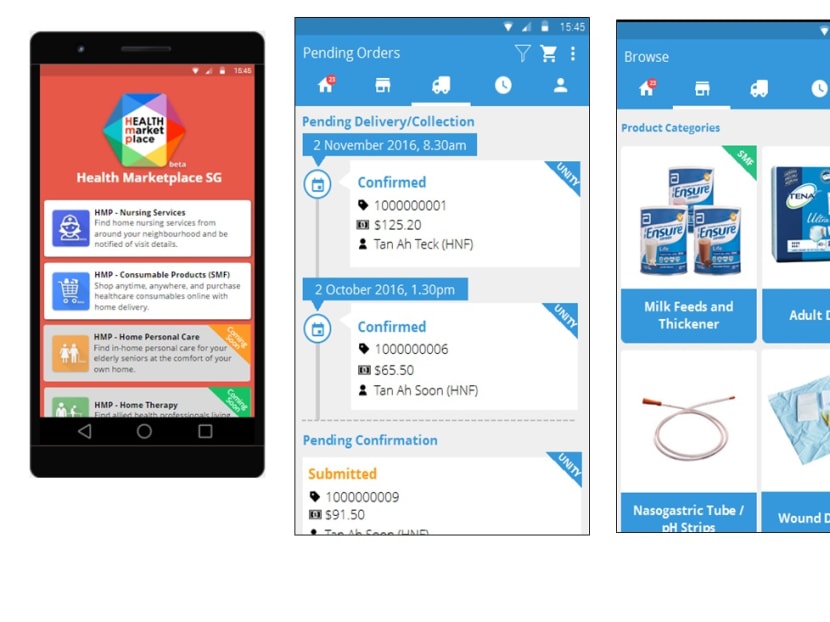From wearable sensors to robots, home care to get tech boost
SINGAPORE — A recently discharged elderly patient, grappling with multiple conditions, such as hypertension or diabetes, can have his blood pressure levels and other vital signs remotely monitored by a care team through his use of wearable sensors.

The new health marketplace app will give patients easy access to personal care services, medical transport, meals-on-wheels and therapist services. Photo: Integrated Health Information Systems, Ministry of Health
SINGAPORE — A recently discharged elderly patient, grappling with multiple conditions, such as hypertension or diabetes, can have his blood pressure levels and other vital signs remotely monitored by a care team through his use of wearable sensors.
He can also receive timely advice to manage his medical conditions without even having to visit the hospital.
At home, the patient can use an exoskeleton suit to help him move around easily when he wants to use the toilet or take a shower. And when he needs extra home care supplies, therapist services, or meals-on-wheels, he can easily order them through an app.
This scenario is all part of Singapore’s vision on how information technology (IT) can be harnessed in various innovative ways for healthcare in the future.
From merely playing a “supportive role” in the past, such as in patient administration, diagnosis and treatment, the use of IT in the healthcare landscape has the potential to be ramped up with new innovations ranging from telemedicine to big data, wearable sensors to personalised medicine, and from robots to 3D printing, said Health Minister Gan Kim Yong on Tuesday (May 30).
Speaking at the ninth National Health IT Summit at the Singapore Expo, which was attended by about 600 healthcare professionals and partner agencies, Mr Gan also shared some new initiatives that the Integrated Health Information Systems (IHiS), the technology agency for Singapore healthcare, would be introducing.
For instance, a new Vital Signs Monitoring (VSM) platform will be launched later this year, to allow more “regular monitoring, improve patient management and reduce hospital visits and readmissions”, said Mr Gan.
This is part of the push to use telehealth more effectively, which has seen the rolling out of platforms for video consultation and tele-rehab solutions in the last three months.
Such platforms include a nationwide pilot of tele-rehabilitation involving 14 institutions by the IHiS.
Singaporeans can also look forward to a scaled-up Health Marketplace app, which will be available by the end of this year. Those who qualify for the Seniors Mobility and Enabling Fund can tap the money to buy home care supplies using the app.
The enhanced app will have other home care services added on to its menu progressively over the next three years, ranging from personal care services, medical transportation, meals-on-wheels and therapist services.
Currently, there is a pilot by the Singapore Health Services’ (SingHealth) Match-A-Nurse programme, which works like a taxi booking application. Launched last April, it links Singapore General Hospital patients who require home nursing services to nurses living or working close to them.
The Ministry of Health is also focusing on the use of predictive analytics to monitor patients’ conditions. For example, a newly developed predictive model identifies discharged patients who are at risk of multiple readmissions over the next one year.
The model takes into account indicators such as the patient’s age, total length of stay in the last two years, and the total number of specialist outpatient visits in the past one year.
Developed by IHiS, the National Healthcare Group, National University Health System and SingHealth over the past year, the model will allow for proactive early intervention to support these patients.






